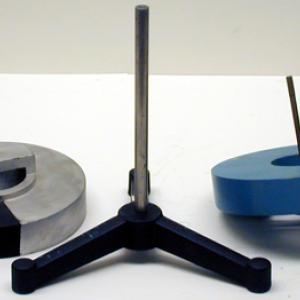College of Liberal Arts & Sciences
1J20.10 - Stable, Unstable, and Neutral Equilibrium
Place the bowling ball on the table an observe it has a stable equilibrium. This will also be the case when it is in the bowl. However, if you turn the bowl over and try to balance the bowling ball on the top the ball will always roll of as that is an unstable configuration.
The cone can be set on its side or on it base and it will be in a stable configuration. It will be an unstable configuration if you try to balance the cone on its point.
The ball with the offset center of mass till balance on the inverted curved block. A ball with the mass distributed as usual will not.
The Maxwell's top are a good demonstration. The top with the rotation point up in the center will be stable on the rod whether it is spinning or not. The top with the rotation point extending below the top will not balance on the rod unless it is spinning.
- George D. Freier, "The Tippy-Top", A Potpourri of Physics Teaching Ideas, p. 56.
- Tik L. Liem, "The Plate Carousel", Invitations to Science Inquiry - Supplement to 1st and 2nd Ed. p. 100.
- Julius Sumner Miller, Q131 & A131, Millergrams II – Some More Enchanting Questions for Enquiring Minds, p. 20 & 82.
- Julius Sumner Miller, Q203 & A203, Millergrams II – Some More Enchanting Questions for Enquiring Minds, p. 59 & 109.
Disclaimer: These demonstrations are provided only for illustrative use by persons affiliated with The University of Iowa and only under the direction of a trained instructor or physicist. The University of Iowa is not responsible for demonstrations performed by those using their own equipment or who choose to use this reference material for their own purpose. The demonstrations included here are within the public domain and can be found in materials contained in libraries, bookstores, and through electronic sources. Performing all or any portion of any of these demonstrations, with or without revisions not depicted here entails inherent risks. These risks include, without limitation, bodily injury (and possibly death), including risks to health that may be temporary or permanent and that may exacerbate a pre-existing medical condition; and property loss or damage. Anyone performing any part of these demonstrations, even with revisions, knowingly and voluntarily assumes all risks associated with them.



